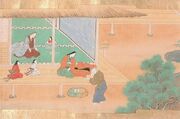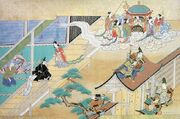
Discovery of Princess Kaguya
The Tale of the Bamboo Cutter (竹取物語 Taketori Monogatari) is a 10th-century Japanese monogatari (fictional prose narrative) containing folkloric elements. It is considered the oldest extant Japanese prose narrative, although the oldest manuscript dates to 1592.
It was also occasionally known as The Tale of Princess Kaguya (かぐや姫の物語 Kaguya-hime no Monogatari), after its protagonist. It primarily details the life of a mysterious girl called Kaguya-hime, who was discovered as a baby inside the stalk of a glowing bamboo plant.
Plot[]

"Taketori no Okina takes Kaguya-hime to his home" by Tosa Hiromichi, c. 1600
One day, while walking in the bamboo forest, an old, childless bamboo cutter called Taketori no Okina (竹取翁 "the Old Man who Harvests Bamboo") came across a mysterious, shining stalk of bamboo. After cutting it open, he found inside it an infant the size of his thumb. He rejoiced to find such a beautiful girl and took her home. He and his wife raised her as their own child and named her Kaguya-hime (かぐや姫 accurately, Nayotake-no-Kaguya-hime "princess of flexible bamboos scattering light"). Thereafter, Taketori no Okina found that whenever he cut down a stalk of bamboo, inside would be a small nugget of gold. Soon he became rich. Kaguya-hime grew from a small baby into a woman of ordinary size and extraordinary beauty. At first, Taketori no Okina tried to keep her away from outsiders, but over time the news of her beauty spread.
Eventually, five princes came to Taketori no Okina's residence to ask for Kaguya-hime's hand in marriage. The princes eventually persuaded Taketori no Okina to tell a reluctant Kaguya-hime to choose from among them. Kaguya-hime concocted impossible tasks for the princes, agreeing to marry the one who managed to bring her his specified item. That night, Taketori no Okina told the five princes what each must bring. The first was told to bring her the stone begging bowl of the Buddha from India, the second a jeweled branch from the mythical island of Hōrai, the third the legendary robe of the fire-rat of China, the fourth a colored jewel from a dragon's neck, and the final prince a cowry shell born of swallows.
Realizing that it was an impossible task, the first prince returned with an expensive bowl, but after noticing that the bowl did not glow with holy light, Kaguya-hime saw through his deception. Likewise, two other princes attempted to deceive her with fakes, but also failed. The fourth gave up after encountering a storm, while the final prince lost his life (severely injured in some versions) in his attempt.
After this, the Emperor of Japan, Mikado, came to see the strangely beautiful Kaguya-hime and, upon falling in love, asked her to marry him. Although he was not subjected to the impossible trials that had thwarted the princes, Kaguya-hime rejected his request for marriage as well, telling him that she was not of his country and thus could not go to the palace with him. She stayed in contact with the Emperor, but continued to rebuff his requests and marriage proposals.
That summer, whenever Kaguya-hime saw the full moon, her eyes filled with tears. Though her adoptive parents worried greatly and questioned her, she was unable to tell them what was wrong. Her behavior became increasingly erratic until she revealed that she was not of this world and must return to her people on the Moon. In some versions of this tale, it is said that she was sent to the Earth, where she would inevitably form material attachment, as a temporary punishment for some crime, while in others, she was sent to Earth for her own safety during a celestial war. The gold that Taketori no Okina had been finding had in fact been a stipend from the people of the Moon, sent down to pay for Kaguya-hime's upkeep.

Kaguya-hime goes back to the Moon
As the day of her return approached, the Emperor sent many guards around her house to protect her from the Moon people, but when an embassy of "Heavenly Beings" arrived at the door of Taketori no Okina's house, the guards were blinded by a strange light. Kaguya-hime announced that, though she loved her many friends on Earth, she must return with the Moon people to her true home. She wrote sad notes of apology to her parents and to the Emperor, then gave her parents her own robe as a memento. She then took a small taste of the elixir of life, attached it to her letter to the Emperor, and gave it to a guard officer. As she handed it to him, the feather robe was placed on her shoulders, and all of her sadness and compassion for the people of the Earth were forgotten. The heavenly entourage took Kaguya-hime back to Tsuki-no-Miyako (月の都/京; lit. "the Capital of the Moon"), leaving her earthly foster parents in tears.
The parents became very sad and were soon put to bed sick. The officer returned to the Emperor with the items Kaguya-hime had given him as her last mortal act, and reported what had happened. The Emperor read her letter and was overcome with sadness. He asked his servants, "Which mountain is the closest place to Heaven?", to which one replied the Great Mountain of Suruga Province. The Emperor ordered his men to take the letter to the summit of the mountain and burn it, in the hope that his message would reach the distant princess. The men were also commanded to burn the elixir of immortality since the Emperor did not wish to live forever without being able to see her. The legend has it that the word immortality (不死 fushi, or fuji) became the name of the mountain, Mount Fuji. It is also said that the kanji for the mountain, 富士山 (literally "Mountain Abounding with Warriors"), are derived from the Emperor's army ascending the slopes of the mountain to carry out his order. It is said that the smoke from the burning still rises to this day. (In the past, Mount Fuji was much more volcanically active.)
Literary connections[]
Elements of the tale were drawn from earlier stories. The protagonist Taketori no Okina, given by name, appears in the earlier poetry collection Man'yōshū (c. 759; poem# 3791). In it, he meets a group of women to whom he recites a poem. This indicates that there previously existed an image or tale revolving around a bamboo cutter and celestial or mystical women.
A similar retelling of the tale appears in the c. 12th century Konjaku Monogatarishū (volume 31, chapter 33), although their relation is under debate.
Banzhu Guniang[]
In 1957, Jinyu Fenghuang (金玉鳳凰), a Chinese book of Tibetan tales, was published.[9] In early 1970s, Japanese literary researchers became aware that "Banzhu Guniang" (班竹姑娘), one of the tales in the book, had certain similarities with The Tale of the Bamboo Cutter. Initially, many researchers thought that "Banzhu Guniang" must be related to Tale of Bamboo Cutter, although some were skeptical.
In 1980s, studies showed that the relationship is not as simple as initially thought. Okutsu provides extensive review of the research, and notes that the book Jinyu Fenghuang was intended to be for children, and as such, the editor took some liberties in adapting the tales. No other compilation of Tibetan tales contains the story.
A Tibet-born person wrote that he did not know the story. A researcher went to Sichuan and found that, apart from those who had already read "Jinyu Fenghuang", local researchers in Chengdu did not know the story. Tibetan informants in Ngawa Tibetan and Qiang Autonomous Prefecture did not know the story either.